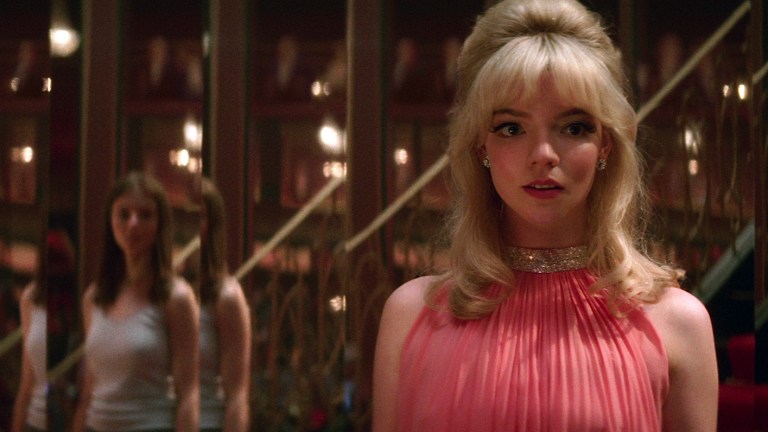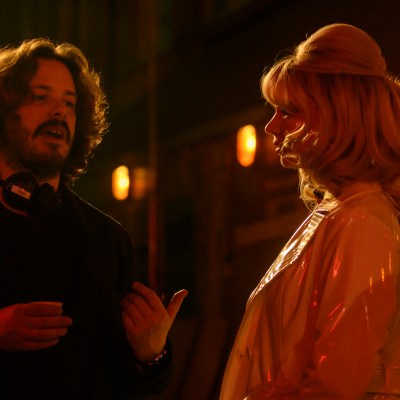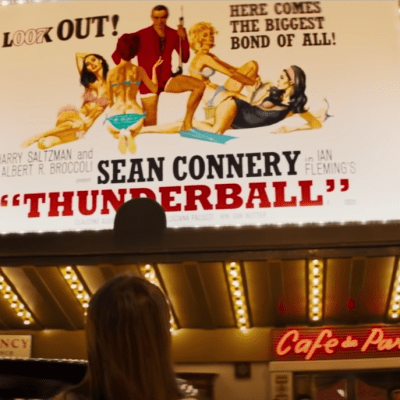Last Night in Soho Ending Explained
We unpack the bloody ending and larger themes of Edgar Wright’s new horror movie, Last Night in Soho.

This article contains Last Night in Soho spoilers.
Thomasin McKenzie’s Eloise Turner is a young woman who’s always been haunted by ghosts. That was true at the beginning of Edgar Wright’s Last Night in Soho and it proves just as accurate by the end when she smiles at a blonde haired specter in the mirror. But then learning to live with your spirits, including the horror that comes from their legacies, is all part of growing up. And for Eloise—or Ellie T. as she muses at one point—that takes on quite literal connotations.
Perhaps this is why the climax of Wright’s first psychological horror movie has taken so many audiences by surprise when it cuts straight for the jugular. Up until that point, we’d been led to believe Ellie’s dreams were taking her back to 1965 in order to witness the downward spiral of another young woman who already cast an otherworldly spell before her death: Anya Taylor-Joy’s mysterious Sandie. And yet, by movie’s end, we learn the brusque landlord in her flat, the elderly Ms. Collins (Diana Rigg), has been Sandie this entire time—alive but trapped in a hell of her own making. Well her making, plus the aid of others: namely Jack (Matt Smith) and the johns, who were users and abusers all.
The film then pivots toward the giallo and Grand Guignol as “Sandie” in both past and present takes a knife to the girl who would save her soul. It’s a fairly shocking turn of events, and one which has made and broken the film for a number of my colleagues. But how could Sandie and Ms. Alexandra Collins be the same person? And more importantly, why is it so pivotal for Ellie to still see the girlhood innocence in the woman chasing her up the stairs with a knife?
Why Eloise Saw Sandie as a Ghost
The twist of Sandie being the only technical killer in this story is jarring since for so much of the film, Ellie is able to walk in Sandie’s shoes. From the first moment she goes to sleep in old Ms. Collins’ ancient flat, she is transported to a lovely evening in Soho where Sandie can dominate an entire ballroom just by standing next to the entrance. All ethereal charm and brash confidence in an age where it was considered risqué for a young woman to attend a nightclub alone, Sandie appears as transgressive for her era as many of the other pop culture icons Ellie keeps posters of on her wall: Audrey Hepburn’s fictional Holly Golightly or the real singer Sandie Shaw (who’s stage name Alexandra Collins has clearly borrowed).
It’s an intoxicating experience for Eloise, who is painfully introverted and lost in a sea of her own loneliness in the big city. However, just because she is watching the world through Sandie’s eyes does not necessarily mean Sandie’s the one who invited her. She never sees Sandie’s life outside of the times she meets men who attempt to posses her, including on this first magical night out on the Soho town where Sandie catches the eye of Matt Smith’s Jack, a fella who pretends to be a talent manager but is more of a self-aggrandizing pimp. He tips his hat toward Sandie’s independence like Sean Connery’s James Bond would for a potential conquest—notably Sandie orders a Vesper martini after passing a Thunderball poster in the same sequence—but it’s only so he can make her his… and anyone else who will pay.
Every sequence we see in ’65 is about Sandie’s increasingly terrifying encounters with Jack or the men he forces her to go to bed with in the very flat space Ellie has rented in 2021. These are the ghosts who’ve summoned Eloise’s supernatural sensitivities to the past. Recall that at the beginning of the film, Eloise has become accommodated to an entire childhood where her mother’s phantom watches her from her bedroom mirror—she doesn’t even tell her grandmother (Rita Tushingham) about how frequent Mum’s spectral visits are.
Unfortunately, moving to London has attracted the interest of spirits whom Eloise is not yet equipped to handle the attention of; lecherous men whom Sandie eventually murdered in that same room and hid the bodies of in the walls and floorboards (one presumes the smell must’ve been something awful for the back half of the ‘60s).
This is the reason Ms. Collins never left this building. When we first meet her, she tells Ellie that she lived here most of her life and eventually bought the building: she is chained to this dreary spot because if she ever sold it or let someone renovate, they’d discover the literal bodies she left in her wake. The only person who even remembers she once went by Sandie is Lindsay (Terence Stamp), the old-time copper and ladies man whom Ellie initially mistakes for Old Man Jack. He was the sole man who asked for Sandie’s real name in her youth, seeing Alex’s pain behind Sandie’s facade. This is why he tells Ellie that “Alex killed Sandie.”
But Alex also killed a lot of other blokes too, hence the ghosts taking Eloise back in time. Like the spirits in The Sixth Sense, they’re pleading for Ellie’s help, asking for her to end their earthly torment—which apparently lasts as long as Alexandra breathes. Of course Ellie has good reason to deny their lamentations…
The Spirit of the ‘60s
Beyond the plot mechanics of the twist, the Last Night in Soho ending works in large part because of late Dame Diana Rigg, and both what she represented in this movie and in her own life. As one of the great icons of UK culture in the ‘60s, Rigg was the star of the series The Avengers from ’65 through ’68, and she appeared in movies as synonymous with that era as the 007 flick On Her Majesty’s Secret Service (1969). Like the character of Sandie, Rigg was at the heart of swinging London’s mod culture as it swept Carnaby Street.
In the context of Last Night in Soho, Rigg’s final film, she thus represents the true living memory of that world—which by the hardness of her stare is not nearly so rosy and beatific as pop culture has reduced it to be after 50 years of nostalgia. Indeed, the romantic nostalgia in Soho extends far beyond Ellie’s starstruck eyes for Sandie. Their relationship is merely a metaphor for, yes, Wright’s own affection for the ‘60s zeitgeist, but also everything from Austin Powers to the last film made by Wright’s buddy Quentin Tarantino, Once Upon a Time… in Hollywood (1969).
Tarantino’s movie, which was nominated for Best Picture at the Oscars, celebrates everything sentimentalized about this decade, albeit in a slightly different context—the California Dreamin’ and Summer of Love at the end of the epoch. But like so many other films about this moment in time, there’s a universal wistfulness about what a paradise future generations missed out on, and it’s usually personified by a free and feminine spirit shaking off the doldrums of the post-war years. In the case of OUATIH, that was summed up by Margot Robbie’s enchanting but largely parabolic version of Sharon Tate, who became the idol of her age. The youthful ‘60s spirit who should’ve lived and danced forever.
Well, Anya Taylor-Joy’s equally effervescent presence initially looks the same in Ellie’s eyes. She’s a free-loving and independent woman who despite all her exuberant movement seems to glide on air. But those romanticized airs are fleeting; affectations as meticulously hand-crafted as the pink frock Ellie attempts to mimic in her design class. Underneath the glamour is a real girl who is as alone in the big city as Ellie, and who lived at a time that celebrated her youth and sexuality, yes, but only inasmuch as it served the rigged game she was set-up to lose.
She plays the free spirit the first night she meets Jack, who will punch the sleaze bucket in a tux when he calls Sandie a slut, but Jack will eventually use that same word after he’s gotten what he personally wants out of her and now looks to control her body for other purposes. The alleged sexual liberation of the ‘60s—which was playfully symbolized in its time by pop culture as chauvinistic as those early Connery and Ian Fleming James Bond stories we see referenced—was more often than not a one-sided affair that still favored the pleasures and assumed dominance of men.
Last Night in Soho takes a lurid and fantastical look at that ugliness behind its romantic phantom’s mask, and behind our own often simplistic and misleading rose-tinted glasses. It forces Eloise and audiences to see the horror of “the decade of youth.” Even Stamp’s old Lindsay, who was the one man in Sandie’s youth to actually see the real suffering Alexandra beneath Sandie’s pretenses, only seemed to want to help her because of her beauty. Her “loveliness.” He said she’s too good for this gutter, but as his older countenance warned Ellie, he liked to think he “protected the girls” as much as kept them in line back in the day—Alex was the exception, not the rule.
Ergo, when old Ms. Collins goes Suspiria on Ellie (Argento, not Guadagnino) and starts chasing Eloise up the stairs with a butcher’s knife, Ellie cannot condemn her. Alex/Sandie played a game she could never win, and even if she did something as awful as murder a dozen men, they murdered her own innocence and dreams for their seedy pleasures. They called her “lovely,” but they built a prison for her that she could never leave, as literalized by her being trapped in that same goddamn room where her life was ruined in her final moments alive. When Alex realizes the game is over, her personal hell never looks more tangible as when she sits on her old bed surrounded by flames.
Ellie won’t kill her; she’ll even forgive her. Still, it’s far too late for Sandie to ever leave that room.
The Ghost Beside You and the Eerie End Credits
The very end of the film shows that after enough time passes, Ellie has endured and even thrived. She has successfully launched her own fashion show as a student with styles inspired by the ‘60s and Sandie’s unearthly countenance. But Ellie herself is no longer beholden to that spell. She’s dyed her hair brown again and in a style that is neither as girlish as how she was introduced or a throwback to a bygone era.
She’s learned from the past and carries those lessons with her—like her ghosts. We see those too, in the shapes of her mother and now also Sandie, youthful and free again. Both watch Eloise every time she looks in the glass. That’s because to paraphrase Faulkner, the past is never dead; it’s not even past. Eloise will always love her mother, just as she’ll always love the ‘60s culture which inspires her and is embodied by Sandie’s shade. But seeing them clearly, and learning to accept their legacies, warts and all, allows her to move through the world as an adult.
As Rigg’s old Alexandra said, this is London. Someone’s died in every room and in every building, and on every street corner. You accept their world as your own simply by breathing in the same space.
It’s a line of dialogue that Wright told me he wrote because he believes it. Which also explains the eerie final images of the film. During the end credits, Wright evades doing anything as tacky as a post-credits scene or final jump scare. Nonetheless, the last images roll by during the end credits as we see the streets of Soho abandoned and vacant. Occupied only by their own ghosts and the half-forgotten memories of worlds long lost and far older than swinging London.
Wright revealed to us that those quiet, moving images were a spur of the moment choice which he filmed during London’s lockdown last year.
“It took me a few months to summon up the courage to walk through [Soho] in lockdown,” Wright said, “but it was completely and utterly deserted, which added an extra level of poignancy to it. There’s a lot of added poignancy too since we shot the movie, not least because two actresses in the movie are no longer with us. And then there’s another part of it that’s bittersweet or elegiac in a way. Soho is rapidly changing. Some of those buildings with ghosts in them, they’re just going forever, which is very sad.”
He continued, “So I walked around and saw how deserted it was, and I called my production designer and my line producer and said, ‘Hey, you’ve got to meet me in Soho at night, take a look at this.’ So then we took photos, and then we actually went out with a crew and shot it… That was something I felt was, in a way, like a little epilogue to the movie by showing what Soho was like right now.”
A memory of a time that’s already gone—but which will always stay with us.
Last Night in Soho is in theaters now.


